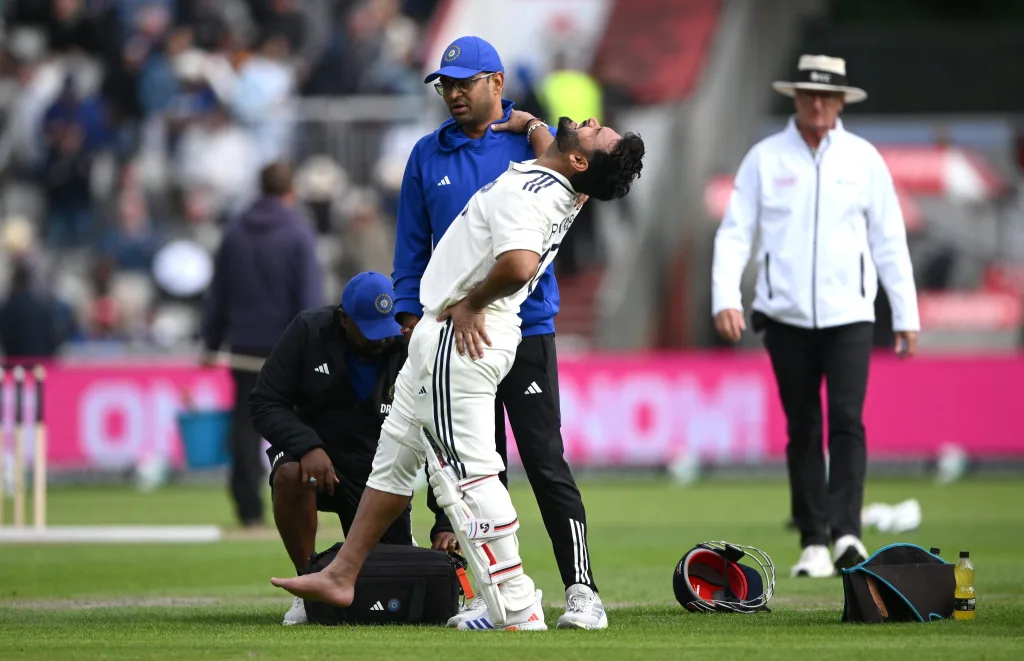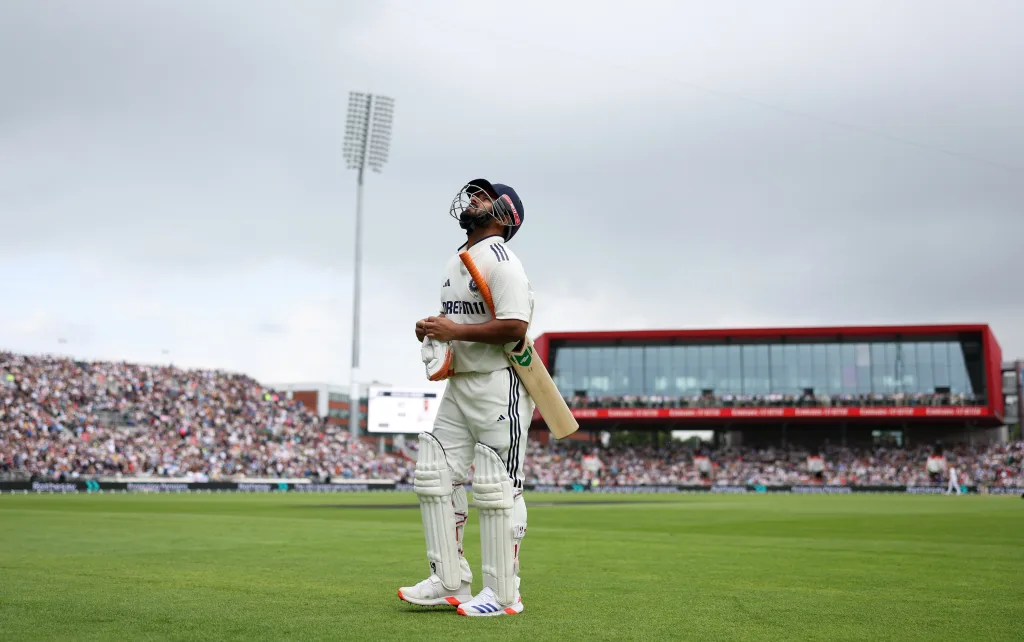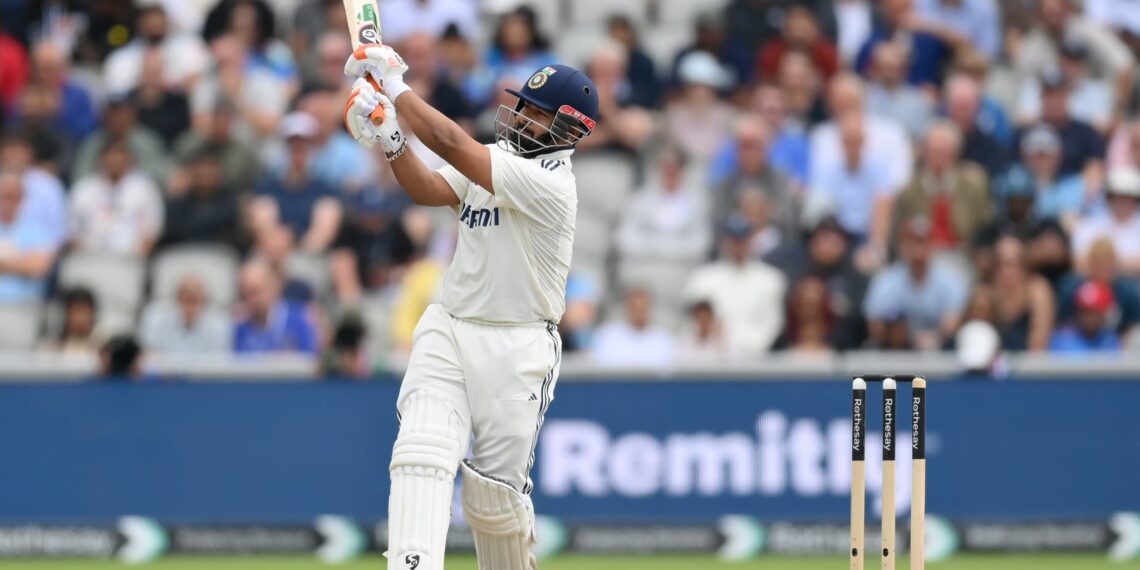The world of cricket witnessed a defining moment when Rishabh Pant limped back to the crease with a fractured foot, refusing to let his team down despite excruciating pain. That act of heroism at Old Trafford has now triggered the most significant rule change in cricket’s playing conditions, as the BCCI becomes the first major cricket board to introduce comprehensive injury replacement provisions beyond concussion substitutes.
Table of Contents
The Catalyst: Rishabh Pant’s Manchester Heroics
The genesis of this revolutionary rule change can be traced to July 24, 2025, during the fourth Test of the Anderson-Tendulkar Trophy at Old Trafford, Manchester. Rishabh Pant was batting on 37 when a failed reverse-lap off Chris Woakes resulted in him cracking his right foot, with a golf cart needed to take him off the field. Despite the visible fracture and intense pain, Pant returned the following day to score a crucial fifty, embodying the spirit of Test cricket.

“He went out to bat with a broken foot and scored a fifty,” teammate Karun Nair revealed. “He inspired so many of us in the dressing room and showed the kind of player and person he is by putting the team first.” This heroic effort not only saved India from a potential collapse but also exposed a glaring gap in cricket’s playing conditions.
BCCI’s Revolutionary Response
Recognizing the need for player welfare without compromising competitive balance, the BCCI has now introduced the most comprehensive injury replacement rule in cricket history. The Board of Control for Cricket in India has amended its playing conditions and introduced a new rule for the 2025-26 domestic season, rolling out the “serious injury replacement” rule for multi-day matches.
Key Features of the New Rule
The BCCI’s new regulation represents a significant evolution from existing cricket protocols:
Qualifying Injuries:
- The injury must have occurred due to an external blow and result in fracture / deep cut / dislocation etc.
- The injury must render the player unavailable for the remainder of the match
- Must be sustained during active play within the designated playing area
Authorization Process:
- Onfield umpires shall be the final authority to decide on the extent of serious injury and allowability of Serious Injury Replacement
- Team manager must submit formal documentation to the BCCI Match Referee
- Medical consultation mandatory for approval
Tournament Coverage and Limitations
The BCCI has strategically implemented this rule with specific parameters:
| Tournament Category | Rule Application | Reason |
|---|---|---|
| Multi-day Domestic (Ranji Trophy, Duleep Trophy) | Applicable | Primary testing ground |
| Under-19 Tournaments (CK Nayudu Trophy) | Applicable | Youth development focus |
| Vijay Hazare Trophy (50-over) | Not applicable | White-ball exclusion |
| Syed Mushtaq Ali Trophy (T20) | Not applicable | Limited overs format |
| Indian Premier League | Not applicable | Franchise tournament |
The Anderson-Tendulkar Trophy: A Series of Painful Lessons
The recent India-England series became an unintended laboratory for injury management in cricket. Rishabh Pant fractured his foot in the fourth match and struggled while batting. Woakes suffered a shoulder injury in the fifth Test. As a result, he didn’t bat in the first innings and walked out with his arm in a sling.
The Human Cost
The series exposed the harsh reality of cricket’s traditional approach to injuries:
- Rishabh Pant: Fractured right foot, returned to bat the next day, scored 50+ runs
- Chris Woakes: Dislocated shoulder, batted with arm in sling during final Test
- Both teams: Forced to continue with effectively 10 players
Expert Opinions: A House Divided
The introduction of injury replacements has polarized cricket’s stakeholders, creating intense debate about the future direction of the sport.
Support from India’s Leadership
India head coach Gautam Gambhir welcomed the idea, saying “Absolutely, I’m all for it” after Pant’s injury during the fourth Test in Manchester. The coaching staff viewed the rule as essential for maintaining competitive balance while protecting player welfare.
English Opposition
England captain Ben Stokes dismissed the idea of injury replacements in Test cricket, describing the conversation as “absolutely ridiculous,” adding that there are too many loopholes in it. Stokes’ opposition reflected traditional cricket thinking that injuries are simply part of the game’s natural challenges.
Comparison with Existing ICC Regulations
The BCCI’s new rule represents a significant expansion beyond current international protocols:
Current ICC Framework
| Rule Type | Scope | Implementation Date |
|---|---|---|
| Concussion Substitute | Head/neck injuries only | August 1, 2019 |
| COVID-19 Replacement | Virus-related withdrawals | June 2020 |
| BCCI Serious Injury | External blow injuries | 2025-26 season |

At present, international cricket only allows substitutions in the event of a player suffering concussion or contracting the Covid-19 virus. The BCCI’s innovation significantly broadens the scope of permissible replacements.
Like-for-Like Principles
Both rules maintain strict like-for-like replacement criteria:
- Concussion Rule: The substitute must be comparable to the injured player in terms of role and skillset
- BCCI Injury Rule: Identify the requested Serious Injury Replacement, who shall be a like-for-like replacement for the player who has sustained the serious injury
Implementation Timeline and Process
The BCCI has established a comprehensive framework for implementing this groundbreaking change:
2025-26 Season Rollout
| Phase | Timeline | Activity |
|---|---|---|
| August 2025 | Current | Umpire education seminars in Ahmedabad |
| August 28, 2025 | Upcoming | Duleep Trophy begins (first tournament) |
| 2025-26 Season | Full Implementation | All multi-day domestic tournaments |
Procedural Requirements
The new rule demands rigorous documentation and oversight:
- Immediate Assessment: On-field medical evaluation
- Formal Request: Team manager submission to match referee
- Medical Consultation: Ground doctor involvement
- Final Decision: Match referee approval
- Implementation: Like-for-like replacement introduction
Global Implications and Future Prospects
The BCCI’s pioneering approach could fundamentally reshape international cricket regulations. The ICC, in reviewing its own playing conditions earlier this year, was open to the idea of its member nations trialling injury substitutes in domestic cricket.
Potential ICC Adoption
If successful in Indian domestic cricket, this rule could influence global cricket governance:
- Testing Phase: BCCI’s 2025-26 domestic season
- Data Collection: Injury patterns and competitive impact analysis
- International Consideration: Potential ICC rule modification
- Global Implementation: Possible adoption across member nations
Player Welfare Revolution
This rule change represents a paradigm shift in cricket’s approach to player safety and welfare:
Medical Advancements
- Recognition of serious injury impact beyond concussions
- Integration of medical expertise in real-time decisions
- Balance between player safety and competitive integrity
Competitive Evolution
- Teams can maintain full strength despite serious injuries
- Reduced pressure on injured players to continue despite pain
- Enhanced quality of cricket through proper player replacement
The Broader Context: Cricket’s Safety Evolution
The BCCI’s decision aligns with broader trends in sports medicine and player welfare:
Historical Precedents
- The England and Wales Cricket Board introduced concussion replacements to English domestic competitions at the start of the 2018 season
- New Zealand’s early adoption of concussion protocols
- Growing awareness of long-term injury consequences
Modern Sports Standards
- Football’s substitution evolution
- Rugby’s head injury protocols
- Cricket’s gradual safety modernization
Economic and Strategic Implications
Beyond player welfare, this rule change carries significant strategic implications:
Tournament Integrity
- Maintains competitive balance throughout matches
- Reduces anti-climactic conclusions due to player shortages
- Enhances spectator experience and broadcast value

Player Development
- Provides opportunities for substitute players to gain experience
- Encourages development of larger squad systems
- Creates pathways for emerging talent
Read More: Official: Newcastle United Secure £43m Jacob Ramsey Transfer from Aston Villa
FAQs
What types of injuries qualify for the BCCI’s new Serious Injury Replacement rule?
Only serious injuries sustained during active play qualify, including fractures, dislocations, and deep cuts caused by external blows. The injury must render the player unable to continue for the remainder of the match, similar to Rishabh Pant’s foot fracture during the Anderson-Tendulkar Trophy.
How does the BCCI’s injury replacement rule differ from the ICC’s concussion substitute rule?
While the ICC’s concussion rule only covers head and neck injuries, the BCCI’s new rule encompasses all serious external injuries like fractures and dislocations. Both require like-for-like replacements and match referee approval, but the BCCI rule has broader scope for injury types.
Will this rule apply to IPL matches or only domestic tournaments?
Currently, the rule applies only to multi-day domestic tournaments like the Ranji Trophy and Duleep Trophy. It will not be used in white-ball formats including the Vijay Hazare Trophy, Syed Mushtaq Ali Trophy, or the Indian Premier League.
Who has the final authority to approve a Serious Injury Replacement?
The on-field umpires have the final authority to decide on the extent of serious injury, but they may consult with the BCCI Match Referee and ground doctors. The team manager must submit a formal request with detailed documentation of the incident and proposed replacement.
Could this BCCI rule influence international cricket regulations globally?
Yes, if successful during India’s 2025-26 domestic season, this rule could encourage the ICC to consider similar provisions for international cricket. The ICC has already expressed openness to member nations trialing injury substitutes in domestic cricket, making global adoption possible.








